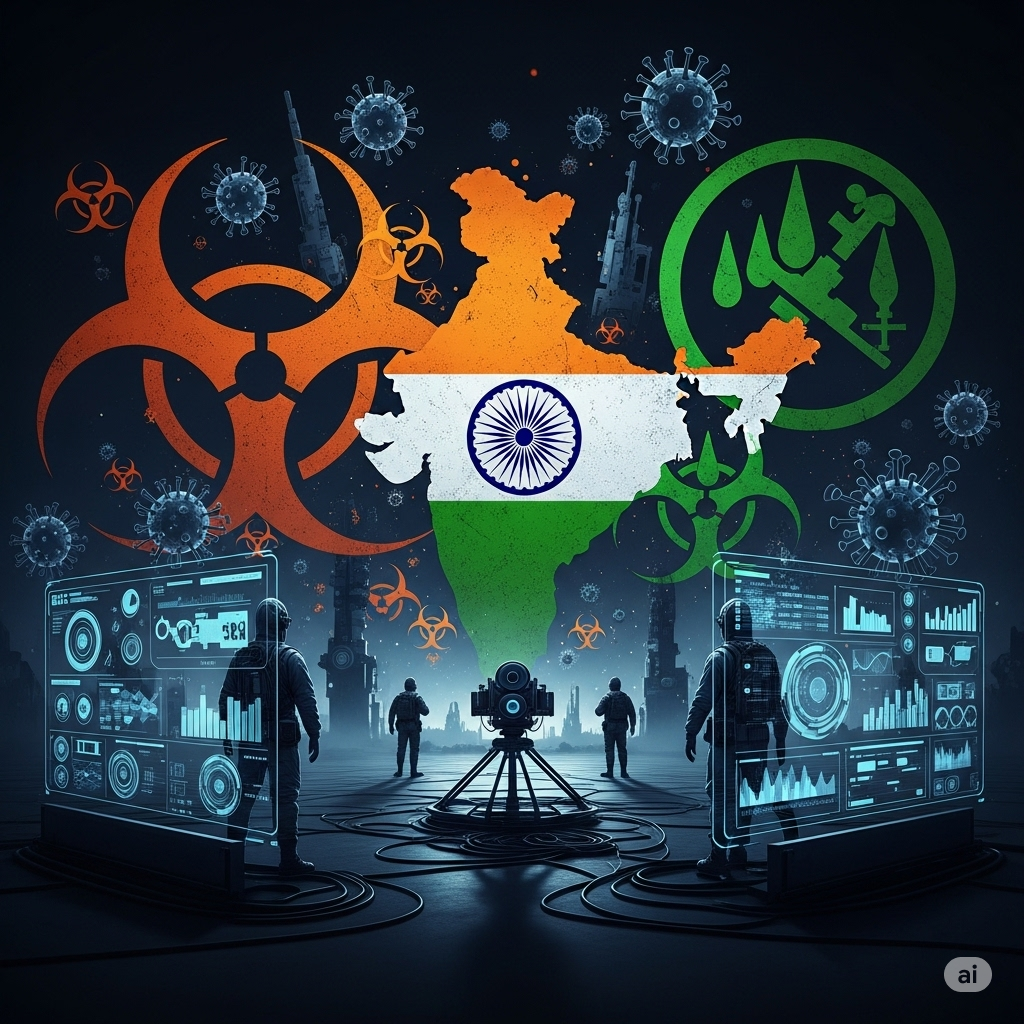
- India’s ascendance as a world power has put it at the cutting edge of not only traditional and cyber threats but also the emerging threat of CBRN warfare.
- These threats are not hypothetical—they are anchored in geopolitical tensions, internal weaknesses, and asymmetric warfare tactics by both state and non-state actors.
- India acknowledges the severe and complex threats of Chemical, Biological, Radiological, and Nuclear (CBRN) threats—whether due to accident, natural occurrence, or deliberate action (including terrorist incidents).
- Operation Black Cloud and other simulations demonstrate India’s increasing emphasis on preparedness, but more is needed for the future, including localised training, AI-driven detection, and SOP harmonisation.
India’s ascendance as a world power has put it at the cutting edge of not only traditional and cyber threats but also the emerging threat of CBRN warfare. These threats are not hypothetical-they are anchored in geopolitical tensions, internal weaknesses, and asymmetric warfare tactics by both state and non-state actors. In the changing threat environment, guaranteeing a strong and integrated national CBRN defence is not only advisable.
Understanding CBRN Threats and India’s Strategic Outlook
With the current geopolitics and industrial dynamics, CBRN hazards- Chemical, Biological, Radiological, and Nuclear—are not theoretical risks but realities in motion. They have turned more asymmetric, with the ability to be used by both governments and non-state entities and with unbalanced effects. As it has a large industry base, high population density, and very active nuclear and biotech industries, India is exposed to both accidental and intentional CBRN events.
| Threat Type | Example Agents | Mode of Dissemination |
| Chemical | Phosgene, Sarin, Mustard Gas | Aerosols, liquids, gases |
| Biological | Anthrax, Botulinum, GMOs | Airborne particles, infected vectors, contaminated water |
| Radiological | Dirty bombs, radioactive dust | Explosives, environmental contamination |
| Nuclear | Nuclear warheads | Strategic missile systems, tactical delivery |
Each type of threat presents specific difficulties in detection, response, and mitigation. Chemical attacks, for example, have immediate symptoms but may be easily neutralised quickly if early detected. Biological attack, however, can remain dormant for days, spreading covertly through populations before developing.
Institutional Framework for CBRN Preparedness in India
India acknowledges the severe and complex threats of Chemical, Biological, Radiological, and Nuclear (CBRN) threats—whether due to accident, natural occurrence, or deliberate action (including terrorist incidents). In consequence, the nation has evolved a multi-agency, multi-layered institutional system of readiness, response, and mitigation. This system works at the national, state, and local levels, backed by policy, infrastructure, and technological advancement.
| Agency | Primary Role in CBRN Defence |
| Defence Research and Development Organisation (DRDO) | Develops indigenous detection, protection, and mitigation systems for CBRN threats. Produces personal protective equipment (PPE), detection kits, portable decontamination systems, and sensors for field deployment. |
| National Disaster Management Authority (NDMA) | Apex body for disaster management. Prepares national policies and guidelines for CBRN emergencies, conducts capacity-building programs, simulates mock drills, and trains first responders. Coordinates inter-ministerial response during incidents. |
| Armed Forces (Army, Navy, Air Force) | Maintain specialised CBRN response units equipped with mobile labs, decontamination vehicles, and detection tools. They are trained to respond rapidly to battlefield or civilian CBRN incidents. |
| Department of Atomic Energy (DAE) | Oversees nuclear safety and security. Through its agencies like BARC and AERB, it monitors radiation, provides technical expertise during radiological events, and ensures nuclear material regulation. |
| Ministry of Health and Family Welfare (MoHFW) | Responsible for public health preparedness. Coordinates hospitals, provides medical countermeasures like antidotes and vaccines, oversees triage and decontamination, and trains medical staff in CBRN protocols. |
Training and research in CBRN risk management are undertaken by the National Institute of Disaster Management (NIDM). Detection units of the CISF provide security to critical infrastructure. SDRFs execute policies of NDMA at the state level and local responders. The NDRF has battalions trained and equipped for CBRN detection, protection, and decontamination.
Recent Equipment and Capability Advances
During February 2025, the Indian Army enhanced its CBRN defence by procuring 223 Automatic Chemical Agent Detection and Alarm (ACADA) systems of Larsen & Toubro in a ₹80.43 crore contract. The systems are capable of real-time detection of chemical agents, ensuring enhanced troop safety. India has also used important CBRN equipment like CBRN Reconnaissance Vehicles (CBRN-RVs) equipped with sensors and GPS, portable chemical detectors, Hazmat suits, mobile decontamination units, and radiation detection equipment like dosimeters and portal monitors.
| Feature | Details |
| Detection Capability | Nerve, blister, choking, and blood agents in vapour and aerosol form |
| Technology | Based on Ion Mobility Spectrometry |
| Operational Use | Detects and alarms troops in real-time |
| Deployment Platform | Armoured vehicles, shelters, and reconnaissance units |
| Significance | Improves response time, enhances battlefield survivability |
CBRN suit is a multi-component system comprising an inherent flame retardant with antistatic, including oil & water repellent, and outer fabric stitched with adsorbent media.
CBRN shelters help in isolating contaminated personnel, while biological detection systems allow for quick identification of pathogens. Integrated early warning systems, connected to CBRN sensors, provide real-time warnings and automated actions.
These advancements demonstrate India’s dedication to modernising and indigenising CBRN defence capabilities, maintaining a strong and well-coordinated response to chemical, biological, radiological, or nuclear threats.
DRDO, NDMA, Armed Forces, and AERB have established a robust institutional framework with cutting-edge instruments like ACADA, Hazmat suits, and mobile decontamination units, but gaps still exist in public preparedness, interagency coordination, and grassroots bio-surveillance.
| CBRN Category | Threat Agent | Detection System | Response Agency | Protection Measures |
| Chemical | Phosgene, MIC | ACADA, CRDS, Colourimetric Kits | NDRF, Army NBC Units | Gas masks, decontamination, and antidotes (Atropine) |
| Biological | GMOs, Viruses | BEWS, PCR Labs | DRDO, ICMR, AFMS | Quarantine, PPE, vaccination |
| Radiological | Isotopes | Geiger Counters, Dosimeters | AERB, DAE Response Teams | Lead shielding, iodine tablets |
| Nuclear | Dirty Bombs | Radiation Portal Monitors | NSG, BARC, Strategic Forces Command | Bunkers, evacuation, contamination control |
India vs CBRN Threats
Harmful Reminders: Actual Events That Rocked the Nation
- The Bhopal Gas Disaster (1984): A Chemical Mishap: A single midnight spill resulted in more than 3,000 deaths right away. The Union Carbide plant’s toxic methyl isocyanate gas destroyed Bhopal and revealed serious weaknesses in emergency preparedness and industrial safety.
- Radiological Failure in the Mayapuri Radiation Leak (2010): Many workers suffered radiation injuries from a Cobalt-60 radioactive source that was sold as trash. This brought to light deficiencies in the regulation and disposal of radioactive waste.
- COVID-19 Pandemic (2020–21): A Call to Biological Vigilance: Despite occurring naturally, the pandemic exposed weaknesses in India’s vaccine distribution, quarantine management, and biosurveillance systems. Improvements in bioresearch infrastructure, public health systems, and diagnostics were also prompted by it.
India can be ready to handle any future CBRN danger with improved cooperation and awareness-raising.
India vs CBRN Threats: Preparedness, Lessons & Global Alliances
A simulated CBRN war scenario called Operation Black Cloud (2026) was based on a fictitious event involving a phosgene tanker crash close to a genetically modified organism (GMO) laboratory in Bhiwadi, Rajasthan. The event set off a massive chemical and biological emergency response.
Step 1: Detection
High-tech sensors like ACADA (Automatic Chemical Agent Detector and Alarm), Biological Early Warning Systems (BEWS), Gas Chromatography-Mass Spectrometry (GC-MS), and thermal drones were used to detect and map areas of contamination. The Atomic Energy Regulatory Board (AERB) was notified on suspicion of radiological exposure from adjacent labs.
Step 2: Military Mobilisation
NBC Battalions of the Indian Army, constituted by DRDO and DIPAS, were deployed. NBC Battalions were provided with Hazmat suits, Self-Contained Breathing Apparatus (SCBA), and CBRN Reconnaissance Vehicles (CBRN-RVs) to evaluate and contain the threat.
Step 3: Medical Response and Evacuation of Civilians
CBRN buses with special filters were used to evacuate over 50,000 individuals. Decon-Z mobile decontamination units were used. Triage camps were established by the Armed Forces Medical Services (AFMS), which also supplied antidotes such as Oximes and Atropine.
Step 4: Reaction to National Security
An investigation into possible sabotage was started by intelligence services and the National Security Council Secretariat (NSCS). Exercise Jal Prahar-II involved joint military-civil drills to improve response cooperation.
Guardians of India’s CBRN Shield: Key National Agencies
| Agency/Organisation | Role in CBRN Defence |
| National Disaster Management Authority (NDMA) | Leads national CBRN policy, planning, guidelines, and simulation-based preparedness. |
| Defence Research and Development Organisation (DRDO) | Develops CBRN detection kits, protective gear, and trains military units. |
| Indian Armed Forces (NBC Battalions) | Provide rapid response, decontamination, and evacuation during CBRN emergencies. |
| National Disaster Response Force (NDRF) | Specialises in search, rescue, and decontamination operations in civilian areas. |
| Atomic Energy Regulatory Board (AERB) | Ensures radiological safety in medical, academic, and industrial sectors. |
| Ministry of Health & ICMR | Manage biological containment, antidote reserves, and medical triage infrastructure. |
| Ministry of Environment, Forest and Climate Change (MoEFCC) | Enforces environmental and biosafety norms for hazardous industries and GMOs. |
India performs high-level exercises like Operation Black Cloud, a training simulation of a CBRN event at Bhiwadi, Rajasthan, to improve preparedness. Following detection by ACADA sensors, BEWS, and GC-MS equipment, DRDO-trained NBC Battalions must be quickly mobilised, and NDRF will assist with civilian evacuation. The Armed Forces Medical Services are responsible for organising triage centres and mobile decontamination vehicles (Decon-Z).
India’s CBRN protection is shared by several national agencies. The DRDO creates protective gear and detection sets, whereas the NDMA determines policies. Field actions are carried out by the NBC and NDRF Battalions. AERB provides regulatory supervision, whereas ICMR coordinates health care.
India collaborates internationally with agencies including the UNODA for WMD disarmament, the WHO for biological outbreak response, the IAEA for radiation control, and the OPCW for chemical safety. WCO and INTERPOL assist in keeping an eye on illegal CBRN trafficking.
Improving inter-agency simulations, AI-powered monitoring, and first responder training at the local level are key to India’s future. India can be ready to handle any future CBRN danger with improved cooperation and awareness-raising.
Conclusion
India is more susceptible to unintentional and deliberate CBRN (Chemical, Biological, Radiological, and Nuclear) threats as a result of its growing international prominence. Gaps still exist in public preparedness, interagency coordination, and grassroots biosurveillance, even though organisations like DRDO, NDMA, Armed Forces, and AERB have established a robust institutional framework with cutting-edge instruments like ACADA, Hazmat suits, and mobile decontamination units.
Operation Black Cloud and other simulations demonstrate India’s increasing emphasis on preparedness, but more is needed for the future, including localised training, AI-driven detection, and SOP harmonisation. Resilience will be improved by fortifying international collaborations with the IAEA, WHO, and OPCW; however, domestic synergy is still crucial. To ensure prompt detection, reaction, and recovery—protecting its people and infrastructure against tomorrow’s invisible threats—India must keep improving its multi-layered CBRN defence.
References:
- https://impressivetimes.com/national/news-3803/
- https://www.defencexp.com/indian-army-has-signed-contract-for-cbrn-defence-equipment/
- https://goodbharat.com/indian-army-procures-cbrn-defence-equipment/
- https://www.newindianexpress.com/nation/2025/Feb/26/indian-army-inks-deal-with-lt-ltd-to-procure-critical-cbrn-defence-equipment
- https://www.businessworld.in/article/indian-army-strengthens-cbrn-defence-with-indigenous-acada-systems-549164
- https://drdo.gov.in/drdo/sites/default/files/inline-files/ACADA_Writeup23072024.pdf
- https://www.wilsoncenter.org/event/the-gravest-threat-to-internal-security-indias-maoist-insurgency
- https://drdo.gov.in/drdo/cbrn-defence-0
- https://www.pib.gov.in/PressReleasePage.aspx?PRID=2106362
- https://www.drdo.gov.in/drdo/sites/default/files/inline-files/CBRN_WPS_MkII_04122023.pdf
- https://www.pib.gov.in/Pressreleaseshare.aspx?PRID=1555409
- https://www.pib.gov.in/PressReleseDetail.aspx?PRID=1897017
- https://ndma.gov.in/capacity_building/mitigation/chemical-biological-radiological-and-nuclear-hazards-training
- https://www.orfonline.org/research/strengthening-cbrn-security-in-india-domestic-strategies-and-global-collaborations
- https://nct-cbnw.com/india-reforming-cbrn-disaster-management-preparedness/
- https://x.com/westerncomd_IA/status/1716100515321594063
Piyush Anand is a Biotechnology Engineering student at Chandigarh University. His primary interest lies in International Affairs, Defence and Strategy. Views expressed are the author’s own.
